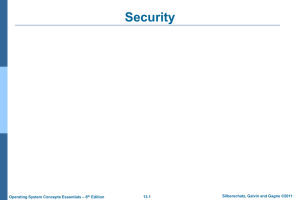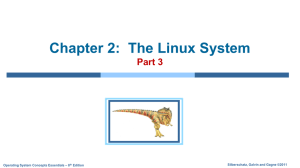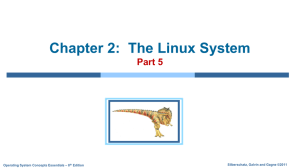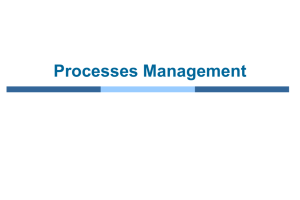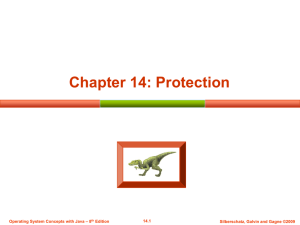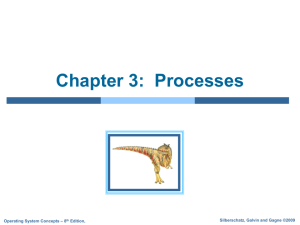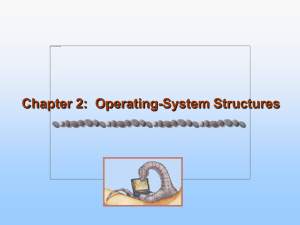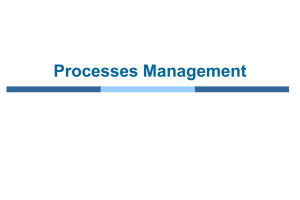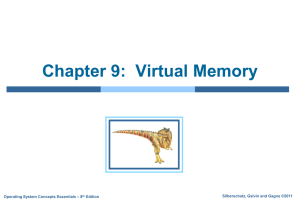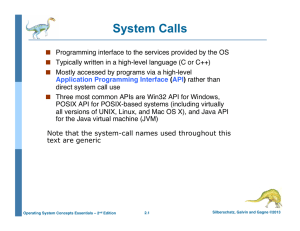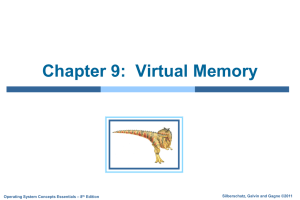Chapter 2: The Linux System Part 2
advertisement
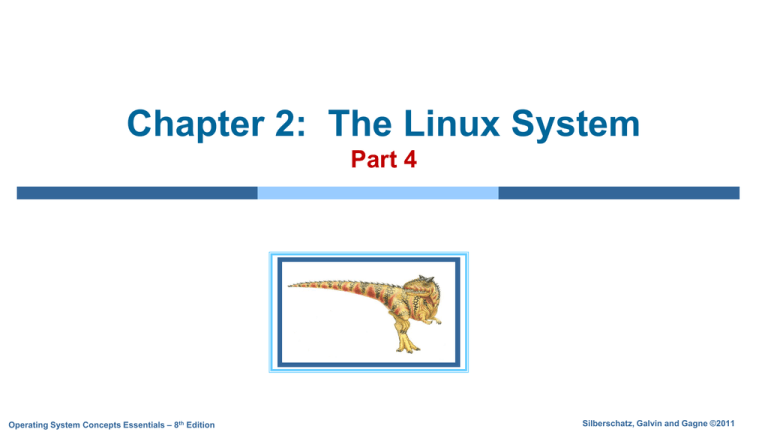
Chapter 2: The Linux System Part 4 Operating System Concepts Essentials – 8th Edition Silberschatz, Galvin and Gagne ©2011 Chapter 2: The Linux System Linux History Design Principles Kernel Modules Process Management Scheduling Memory Management File Systems Input and Output Interprocess Communication Network Structure Security Operating System Concepts Essentials– 8th Edition 15.2 Silberschatz, Galvin and Gagne ©2011 Memory Management Operating System Concepts Essentials – 8th Edition Silberschatz, Galvin and Gagne ©2011 Memory Management Linux’s physical memory-management system has two components: 1. Deals with allocating and freeing pages, groups of pages, and small blocks of memory. 2. Handling virtual memory, memory mapped into the address space of running processes. Operating System Concepts Essentials– 8th Edition 15.4 Silberschatz, Galvin and Gagne ©2011 Memory Management Memory is a continuous set of bits referenced by specific addresses Operating System Concepts Essentials– 8th Edition 15.5 Silberschatz, Galvin and Gagne ©2011 Partition Memory Management Partitions Main memory is divided into a particular number of partitions Programs are loaded into available partitions 10-6 Operating System Concepts Essentials– 8th Edition 15.6 Silberschatz, Galvin and Gagne ©2011 Paged Memory Management Paged memory technique: Processes are divided into fixed-size pages and stored in memory frames Frame: A piece of main memory that holds a process page Page: A piece of a process that is stored into a memory frame Page-map table (PMT): A table used by the operating system to keep track of page/frame relationships Operating System Concepts Essentials– 8th Edition 15.7 Silberschatz, Galvin and Gagne ©2011 Paged Memory Management To produce a physical address, you first look up the page in the PMT to find the frame number in which it is stored Then multiply the frame number by the frame size and add the offset to get the physical address Operating System Concepts Essentials– 8th Edition 15.8 Silberschatz, Galvin and Gagne ©2011 Paged Memory Management Demand paging An important extension of paged memory management Not all parts of a program actually have to be in memory at the same time In demand paging, the pages are brought into memory on demand Page swap The act of bringing in a page from secondary memory, which often causes another page to be written back to secondary memory 10-9 Operating System Concepts Essentials– 8th Edition 15.9 Silberschatz, Galvin and Gagne ©2011 Page Frame Management Page frames are 4KB in Linux. The kernel must keep track of the current status of each frame. Are page frames allocated or free? If allocated, do they contain process or kernel pages? Linux maintains an array of page frame descriptors (one for each frame) of type struct page. Operating System Concepts Essentials– 8th Edition 15.10 Silberschatz, Galvin and Gagne ©2011 Page Frame Descriptors Each descriptor has several fields, including: count - equals 0 if frame is free, >0 otherwise. flags - an array of 32 bits for frame status. Example flag values: – PG_locked - page cannot be swapped out. – PG_reserved - page frame reserved for kernel code or unusable. Operating System Concepts Essentials– 8th Edition 15.11 Silberschatz, Galvin and Gagne ©2011 Managing Physical Memory The page allocator allocates and frees all physical pages; it can allocate ranges of physically-contiguous pages on request. The allocator uses a buddy-heap algorithm to keep track of available physical pages Each allocatable memory region is paired with an adjacent partner Whenever two allocated partner regions are both freed up they are combined to form a larger region If a small memory request cannot be satisfied by allocating an existing small free region, then a larger free region will be subdivided into two partners to satisfy the request. Memory allocations in the Linux kernel occur either statically (drivers reserve a contiguous area of memory during system boot time) or dynamically (via the page allocator). Operating System Concepts Essentials– 8th Edition 15.12 Silberschatz, Galvin and Gagne ©2011 Splitting of Memory in a Buddy Heap Operating System Concepts Essentials– 8th Edition 15.13 Silberschatz, Galvin and Gagne ©2011 Paged Memory Management The demand paging approach gives rise to the idea of virtual memory, the illusion that there are no restrictions on the size of a program. Too much page swapping, however, is called thrashing and can seriously degrade system performance. 10-14 Operating System Concepts Essentials– 8th Edition 15.14 Silberschatz, Galvin and Gagne ©2011 Virtual Memory The VM system maintains the address space visible to each process: It creates pages of virtual memory on demand, and manages the loading of those pages from disk or their swapping back out to disk as required. Operating System Concepts Essentials– 8th Edition 15.15 Silberschatz, Galvin and Gagne ©2011 Virtual Memory (Cont.) The kernel creates a new virtual address space 1. When a process runs a new program with the exec system call 2. Upon creation of a new process by the fork system call Operating System Concepts Essentials– 8th Edition 15.16 Silberschatz, Galvin and Gagne ©2011 Virtual Memory (Cont.) On executing a new program, the process is given a new, completely empty virtual-address space; the program-loading routines populate the address space with virtual-memory regions. Creating a new process with fork involves creating a complete copy of the existing process’s virtual address space. The kernel copies the parent process’s VMA descriptors, then creates a new set of page tables for the child. The parent’s page tables are copied directly into the child’s, with the reference count of each page covered being incremented. After the fork, the parent and child share the same physical pages of memory in their address spaces. Operating System Concepts Essentials– 8th Edition 15.17 Silberschatz, Galvin and Gagne ©2011 Virtual Memory (Cont.) The VM paging system relocates pages of memory from physical memory out to disk when the memory is needed for something else. The VM paging system can be divided into two sections: The pageout-policy algorithm decides which pages to write out to disk, and when The paging mechanism actually carries out the transfer, and pages data back into physical memory as needed Operating System Concepts Essentials– 8th Edition 15.18 Silberschatz, Galvin and Gagne ©2011 Virtual Memory (Cont) This kernel virtual-memory area contains two regions: A static area that contains page table references to every available physical page of memory in the system, so that there is a simple translation from physical to virtual addresses when running kernel code. The reminder of the reserved section is not reserved for any specific purpose; its pagetable entries can be modified to point to any other areas of memory. Operating System Concepts Essentials– 8th Edition 15.19 Silberschatz, Galvin and Gagne ©2011

